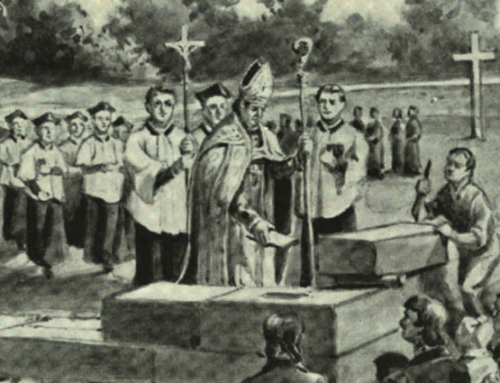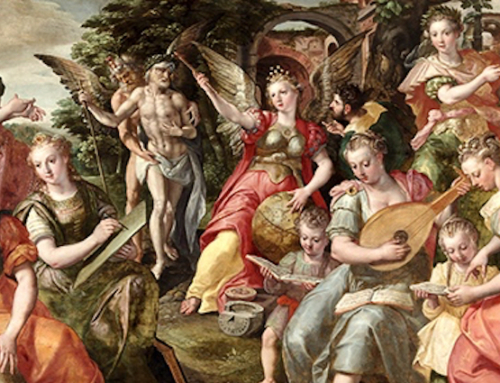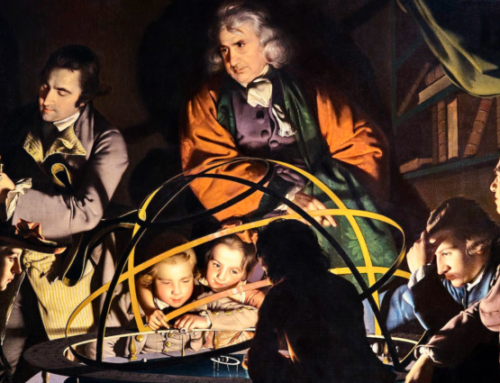We have debts to each other. Debts unto death. Debts that survive every desecration. Debts that knit a common world, a common life…
 I’m at Chesed Shel Emeth cemetery where vandals have scattered gravestones over the Jewish dead.
I’m at Chesed Shel Emeth cemetery where vandals have scattered gravestones over the Jewish dead.
The stones were tossed with twisted discipline, one to the right, one to the left, making the felled granite and marble into a splayed line stretching two blocks. The site resembles a giant spinal column that has been exposed from the earth through earthquake.
I’m not Jewish, so I ask myself, “Why do I feel I have to be here?”
Maybe it’s those fourteen years of my youth in New York, falling in love with Jewish girls. Then, there’re the four years working in software development in Manhattan, surrounded by the haymish warmth of the Yiddish-speaking Orthodox: the married ladies in their helmet shaped wigs, the men with their ear locks that shook like God was whispering to them whenever they moved.
But, I’m not a liberal. I’m deaf to social issues. I am a sixty-five year old Irish Catholic. So, why am I here?
Well, there’s that odd bit of family history. In the late 1950s, my Dad got some life-changing business advice from his Orthodox office mate, which launched my Dad’s success, and made my future possible.
Still, as I look at the tumbling stones I’m ashamed for not having an appropriate emotional response. I tell myself it was probably a bunch of hopped-up teenagers; I get ready to pass on.
But then, there’s this final thing: When I came home to St. Louis, twenty-seven years ago, a Jewish woman, a family friend, worried about me enough to yenta-match me to my wife. She saw to it that a Catholic prep-school boy married a Catholic prep-school girl.
So, why am I ready to help clean up the mess at Chesed Shel Emeth? I owe.
Chesed Shel Emeth cemetery is ensconced in the historically Jewish municipality of University City, Missouri. The huddled stones, the tiny paths, the eggshell white, cameo-shaped daguerreotypes of the deceased, peering from sandstone markers… all these things cast a dreamy spell. Then, there are the little niches where lost infants and their doll-sized stones sleep near the backyards of the surrounding residents, where other children play. All these things make this cemetery seem a faded velvet box of jewels on the dressing table of an exiled princess.
There is an intimacy in this Jewish cemetery not found in gentile burial sites which often aim to look like golf fairways studded with marble. By contrast, Chesed Shel Emeth is a loveable muddle of Roman and Medieval architecture. Old grave stones crowd up to the car curbs. The paths are often hip-narrow. Some graves are suitcase-sized. German-Yiddish sounding names cantor in mute chorus from markers—Landsman, Lehman, Lachterman. Then there’s a klezmer strain from the Ost-Juden memorialized by the families Kandinsky and Blaylock. Some stones herald Sephardic names. This resting place seems like a patch of the Austrian-Hungarian Empire with a touch of Russia and Ladino Spain mixed in.
Across Olive Street Road, Chesed Shel Emeth faces a “Goodwill Industries” and a “Dollar Tree” store. Between them is a shuttered bar and grill available “For Rent or Sale.” Just around the corner is an untended office building which hosts a shabby collectible shop, and a salon for nails, facials, and hair. Behind the “Dollar Tree” and the “Goodwill” store, African-American children play near an abandoned, brick school building, which like the bar and grill is also “For Sale.”
It was in this neighborhood, that 150 or more Jewish headstones were rumbled. No one knows who or why. Everyone agrees: The various kinds of mankind have always lived in harmony in University City. The crime probably had nothing to do with the neighborhood. But in such a melting pot, an attack on Jews is all the more painful.
It’s painful for another reason too.
Chesed Shel Emeth, in the rain—despite her nineteenth-century lineage—looks just a bit like a society matron in an Edith Wharton novel, reduced to Social Security and food stamps. The administrative infrastructure has no office. Although, the owner does have a desk situated at the front of the workmen’s garage. The graves are unraked. The place has a single restroom in the work garage. No office hours are posted.
You ask, “Can Chesed Shel Emeth survive the cost to repair?” First, 150 or so monuments must be craned off the ground and then reset on wooden shivs. Then the stones must be tilted back again for the re-cementing.
I watch the bustle of workmen and cranes levitate the stones back to their footings. All this promises restoration and recovery. The long booms of microphones arc over reporters. All that promises public interest and support. Yet some ancient anxiety squirms in my guts. Despite everything that should make you feel that—in daylight anyway—this arena of old world virtues is safe, the place just doesn’t feel safe.
The western border is protected by rusted and sagging chain link which is in some places no more than five-feet high. There’s no issue of negligence. But death summons curiosity and the itch to transgress. And cemeteries, all cemeteries—in the logic of insurance liability—must be thought of as “attractive nuisances,” at least metaphorically. Places that beg for trespass: like unfenced, empty swimming pools that toddlers crawl into and drown.
In this respect, Chesed Shel Emeth is no different from any gentile cemetery.
During the late 1930s, my father almost got his eyeballs shot out in bb-gun fights held in Calvary Catholic Cemetery on St. Louis’ North Side. In Calvary’s un-ploughed weed fields on the north end, where fresh, innocent earth waited for some future century’s bodies, there my Dad and his friends hunted rabbits, alley cats, birds, and each other. It was there, in Calvary Cemetery, that my dad joined some other boys—each armed with the famous “Red Ryder BB rifle,” and commenced to shoot each other until they each bled.
Similarly, my father-in-law, Col. James Inglis Reid—who also grew up near Calvary Cemetery–had heard of unspecified, sepulchral adventures there. As an adult, “Big Jim” would always shudder each time he drove down W. Florissant Road, past Calvary. He said there were things he and his childhood friends saw there that he refused to discuss.
Col. James Reid won a Silver Star for capturing, while behind enemy lines, twelve Germans and their tank, and then marching both German infantry, and the tank crew, and the tank itself, back to allied capture. The artillery unit he commanded fought in North Africa, Italy, France, and Germany. He received the French Croix de Guerre, the Bronze Star, and a Purple Heart. He participated in the liberation of Dachau.
Yet till the day he died, each time he passed Calvary Cemetery on W. Florissant Road, he got the willies.
And so, we observe: There’s something about cemeteries that brings out a sense of weakness and violation in each of us; and, a cemetery desecration compounds our dread of human effaceability.
So on a day like this, we face the little earthquake of upturned stones at Chesed Shel Emeth. We know that such a desecration violates the Jewish dead. But we also know that it also summons something from the squirming, breathing goys, who also feel their helplessness to fate, and go squishy each time they pass a cemetery.
Because the graveyard desecrator screams, “All life is weak and meaningless. Your life is weak and meaningless. Death proves it is meaningless. And while you thought your life had dignity, it never really did. And these overturned stones prove it.”
And to this, we want to answer back. We want to summon something up in our guts and reject the vandal’s slander. But the horrible truth is this: There is nothing we can say! We are weak. We are mortal. We evaporate in time. We are evanescent, and like the beautiful Achilles so born to die.
And yet, speaking for myself, as I look over at the rustled stones, I can’t but think:
Men and Jews are weak. But, once I knew a Jewish girl, and worked among her kind. Once, I was taught by Jews, and once my father was helped by them. And once one found for me a wife. And what the vandal says about life being meaningless may be true. But there is still at long length this other thing: I am in debt to certain Jews. So I am here the next day raking, and cleaning, and restoring, and you can’t stop that. You can’t stop that, you old destroyer! You can’t stop men knowing this drab and eternal thing: We have debts to each other. Debts unto death. Debts that survive every desecration. Debts that knit for Christian and Jew: a common world, a common life.
Books on the topic of this essay may be found in The Imaginative Conservative Bookstore. The Imaginative Conservative applies the principle of appreciation to the discussion of culture and politics—we approach dialogue with magnanimity rather than with mere civility. Will you help us remain a refreshing oasis in the increasingly contentious arena of modern discourse? Please consider donating now.







One now and then will hear of a cemetery being vandalized and it’s heart breaking. The cemetery where my grandparents and aunt and uncle reside has been vandalized and that a well maintained one; this we can account to childish pranks. But here, despite what police and newspaper articles might say, it has a heavier poignancy as the extent of damage done to this, a Jewish cemetery, tells the real tale.
I hope that contributions and volunteer work will remake this sacred resting place and make it more secure against these violent acts by such hoodlums.
Thanks for your comment, Kevin. I happen to agree with you that in a case like this the motive was anti-Semitism.